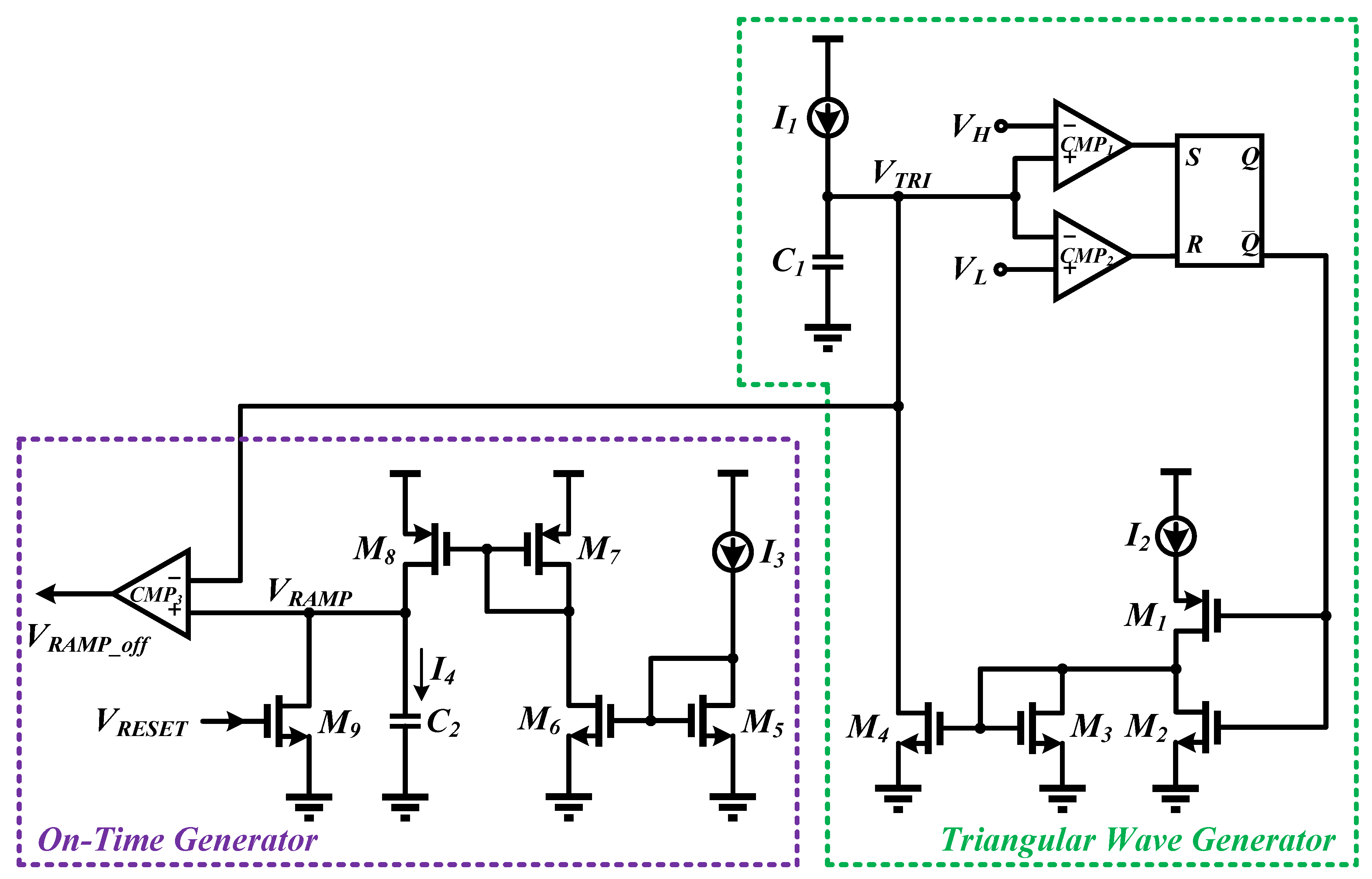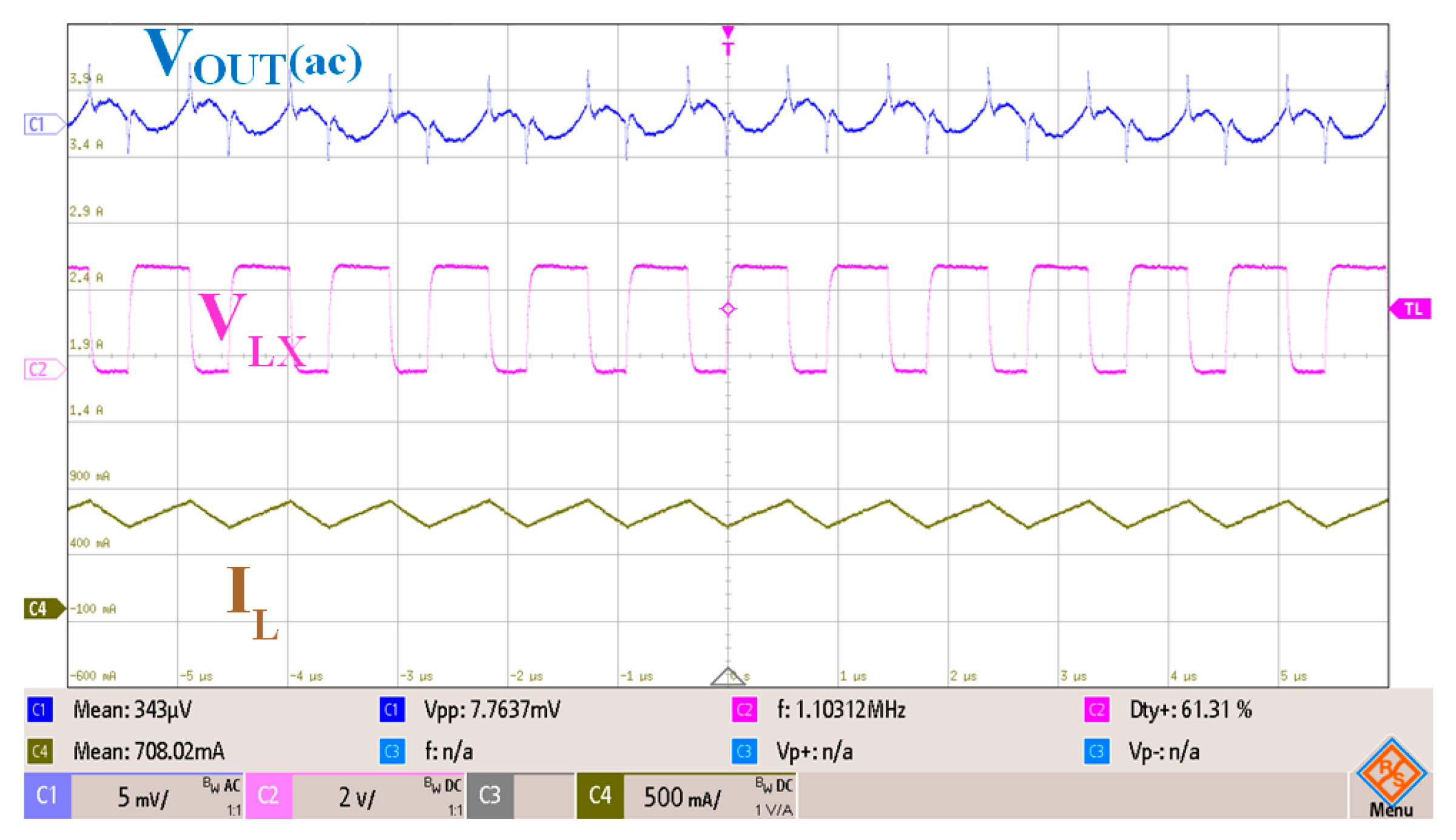A Low EMI DC-DC Buck Converter with a Triangular Spread-Spectrum Mechanism
Abstract
:1. Introduction
2. Electromagnetic Interference of the DC-DC Buck Converter
3. Circuit Implementation
3.1. Proposed Triangular Spread-Spectrum Generator
3.2. Inductive DCR Current Sensing Circuit
4. Experimental Results
5. Conclusions
Author Contributions
Funding
Acknowledgments
Conflicts of Interest
References
- Hsu, Y.-C.; Ting, C.-Y.; Hsu, L.-H.; Lin, J.-Y.; Chen, C.-P. A transient enhancement DC-DC buck converter using dual operating mode control technique. IEEE Trans. Circuits Syst. II Exp. Briefs 2018, 66, 1376–1380. [Google Scholar] [CrossRef]
- Suh, J.-D.; Seok, J.; Kong, B.-S. A fast response PWM buck converter with active ramp tracking control in load transient period. IEEE Trans. Circuits Syst. II Exp. Briefs 2018, 66, 467–471. [Google Scholar] [CrossRef]
- Lee, C.-F.; Mok, P.-K.-T. A monolithic current-mode CMOS DC-DC converter with on-chip current-sensing technique. IEEE J. Solid State Circuits 2004, 39, 3–14. [Google Scholar] [CrossRef]
- Wu, K.-I.; Hwang, B.-T.; Chen, C.-P. Synchronous double-pumping technique for integrated current-mode PWM DC–DC converters demand on fast-transient response. IEEE Trans. Power Electron. 2017, 32, 849–865. [Google Scholar] [CrossRef]
- Lee, Y.-H.; Huang, S.-C.; Wang, S.-W.; Chen, K.-H. Fast transient (FT) technique with adaptive phase margin (APM) for current mode DC–DC buck converters. IEEE Trans. Very Large Scale Integr. (VLSI) Syst. 2012, 20, 1781–1793. [Google Scholar] [CrossRef]
- Huang, H.-H.; Chen, C.-L.; Chen, K.-H. Adaptive window control (AWC) technique for hysteresis DC-DC buck converters with improved light and heavy load performance. IEEE Trans. Power Electron. 2009, 24, 1607–1617. [Google Scholar] [CrossRef]
- Wu, K.-I.; Hung, S.-H.; Shieh, S.-Y.; Hwang, B.-T.; Hung, S.-Y.; Chen, C.C.-P. Current-mode adaptively hysteretic control for buck converters with fast transient response and improved output regulation. In Proceedings of the IEEE International Symposium on Circuits and Systems (ISCAS), Melbourne, Australia, 1–5 June 2014; pp. 950–953. [Google Scholar]
- Hwang, Y.-S.; Wu, T.-H.; Lu, M.-X.; Chen, J.-J. Sub-1-V fast-response hysteresis- controlled CMOS buck converter using adaptive ramp techniques. IEEE Trans. Very Large Scale Integr. (VLSI) Syst. 2013, 21, 1608–1618. [Google Scholar]
- Lin, Y.-C.; Chen, C.-J.; Chen, D.; Wang, B. A ripple-based constant on-time control with virtual inductor current and offset cancellation for DC power converters. IEEE Trans. Power Electron. 2012, 27, 4301–4310. [Google Scholar] [CrossRef]
- Chen, W.-W.; Chen, J.-F.; Liang, T.-J.; Wei, L.-C.; Huang, J.-R.; Ting, W.-Y. A novel quick response of RBCOT with VIC ripple for buck converter. IEEE Trans. Power Electron. 2013, 28, 4299–4307. [Google Scholar] [CrossRef]
- Li, C.-H.; Chiu, H.-J.; Lo, Y.-K.; Wang, C.-C. Adaptive on-time control with adjustable virtual ripple and offset cancellation for buck converter. IET Power Electron. 2015, 12, 2418–2428. [Google Scholar] [CrossRef]
- Chen, C.; Chen, D.; Tseng, C.; Chang, Y.; Wang, K. A novel ripple-based constant on time control with virtual inductor current ripple for buck converter with ceramic output capacitors. In Proceedings of the IEEE APEC, San Francisco, CA, USA, 21–25 February 2011; pp. 1488–1493. [Google Scholar]
- Chen, W.-C.; Wang, C.-S.; Su, Y.-P.; Lee, Y.-H.; Lin, C.-C.; Chen, K.-H.; Du, M.-J. Reduction of equivalent series inductor effect in delay ripple reshaped constant on-time control for buck converter with multilayer ceramic capacitors. IEEE Trans. Power Electron. 2013, 28, 2366–2376. [Google Scholar] [CrossRef]
- Lee, Y.-H.; Wang, S.-J.; Chen, K.-H. Quadratic differential and integration technique in V2 control buck converter with small ESR capacitor. IEEE Trans. Power Electron. 2010, 25, 829–838. [Google Scholar]
- Su, Y.-P.; Lee, Y.-H.; Chen, W.-C.; Chen, K.-H.; Lin, Y.-H.; Tsai, T.-Y.; Huang, C.-C.; Lee, C.-C. A pseudo-noise coded constant-off-time (PNC-COT) control switching converter with maximum 18.7-dBm peak spur reduction and 92% efficiency in 40 nm CMOS. In Proceedings of the IEEE Symposium on VLSIC, Kyoto, Japan, 11–14 June 2013; pp. C170–C171. [Google Scholar]
- Du, Y.; Liu, Q.; Huang, A.-Q. Current-mode hysteretic buck converter with spur-free control for variable switching noise mitigation. In Proceedings of the ECCE, Raleigh, NC, USA, 15–20 September 2012; pp. 1849–1856. [Google Scholar]
- Liu, P.-J.; Tai, J.-N.; Chen, H.-S.; Chen, J.-H.; Chen, Y.-J. Spur-reduction design of frequency-hopping DC–DC converters. IEEE Trans. Power Electron. 2012, 27, 4763–4771. [Google Scholar] [CrossRef]



















| Parameter | This Work |
|---|---|
| Technology (nm) | 180 |
| Control scheme | Constant on-time |
| Switching frequency (MHz) | 0.7~1.3 |
| Input voltage (V) | 2.9~3.3 |
| Output voltage (V) | 1.8 |
| Inductor (μH)/Capacitor (μF) | 3.3/10 |
| Peak efficiency (%) | 94 |
| Load current (mA) | 50~700 |
| Transient recovery time for step-up load (μs) | 5 |
| Transient recovery time for step-down load (μs) | 5 |
| Chip area (mm2) | 1.38 |
© 2020 by the authors. Licensee MDPI, Basel, Switzerland. This article is an open access article distributed under the terms and conditions of the Creative Commons Attribution (CC BY) license (http://creativecommons.org/licenses/by/4.0/).
Share and Cite
Lin, J.-Y.; Hsu, Y.-C.; Lin, Y.-D. A Low EMI DC-DC Buck Converter with a Triangular Spread-Spectrum Mechanism. Energies 2020, 13, 856. https://doi.org/10.3390/en13040856
Lin J-Y, Hsu Y-C, Lin Y-D. A Low EMI DC-DC Buck Converter with a Triangular Spread-Spectrum Mechanism. Energies. 2020; 13(4):856. https://doi.org/10.3390/en13040856
Chicago/Turabian StyleLin, Jing-Yuan, Yi-Chieh Hsu, and Yo-Da Lin. 2020. "A Low EMI DC-DC Buck Converter with a Triangular Spread-Spectrum Mechanism" Energies 13, no. 4: 856. https://doi.org/10.3390/en13040856




